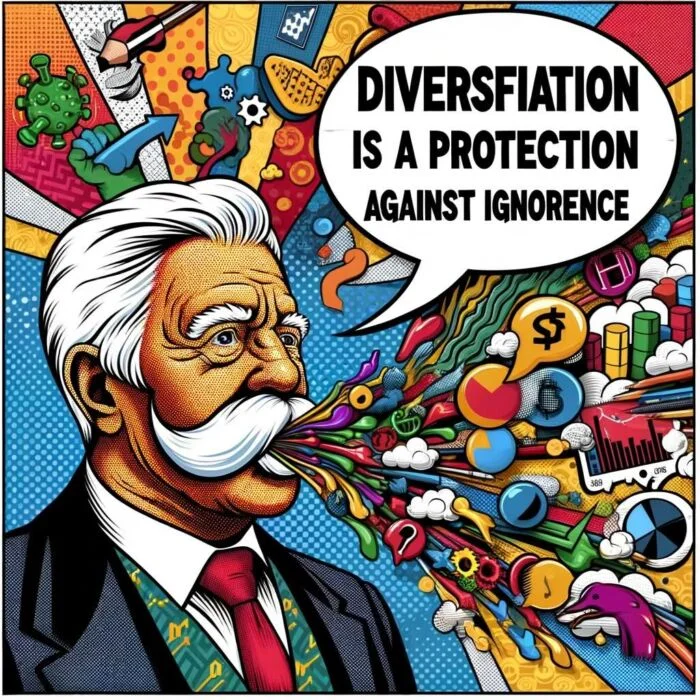The journey of Warren Buffett, the Oracle of Omaha, is a testament to the dynamic nature of investment strategy. His evolution as an investor – from a young boy fascinated by numbers, to the billionaire chairman of Berkshire Hathaway – showcases a profound ability to adapt and refine his approach in response to changing market environments and personal growth. This article offers a comprehensive exploration of this evolution, examining key phases in Buffett’s investment journey.

Born in 1930, Warren Buffett displayed an early knack for business and investment. From selling chewing gum door-to-door as a kid, to buying his first stock at just 11 years old, Buffett’s early years were characterized by an unusual aptitude for making money. After studying under the tutelage of Benjamin Graham at Columbia Business School, he would go on to apply and modify Graham’s teachings, eventually developing his unique investment philosophy.
This distinctive approach to investing – marked by an unwavering commitment to value, long-term thinking, and ethical conduct – has made Buffett one of the most successful and respected investors in the world. Yet, the path to this success was not a straight line, but rather a journey of learning, adaptation, and continual refinement. Let’s dive into this intriguing evolution of Warren Buffett’s investment style.

Early Years: Buffett’s First Investments & Benjamin Graham’s Influence
As a young boy in Omaha, Nebraska, Buffett was already showing signs of his future as a savvy investor. His early ventures ranged from selling newspapers and golf balls to owning pinball machines in local barber shops. However, his first formal introduction to investing came at the tender age of 11 when he purchased shares of Cities Service Preferred for himself and his sister. While this early investment had its ups and downs, it offered young Buffett valuable lessons about market patience and conviction.

Introduction to Benjamin Graham and His Influence on Young Buffett
It wasn’t until Buffett attended Columbia Business School that he met the man who would fundamentally shape his investment approach – Benjamin Graham. Graham, often called the “father of value investing,” left a deep impression on Buffett. His teachings on investing provided the foundational principles that Buffett would adopt and modify throughout his career.
Graham’s focus on careful analysis, rational decision-making, and margin of safety struck a chord with Buffett. He became a dedicated disciple of Graham, even working for him at Graham-Newman Corp after graduation. This period was instrumental in forming Buffett’s early investment philosophy.

Graham’s Value Investing Approach and How It Shaped Buffett’s Early Strategy
Benjamin Graham’s value investing approach centered on buying stocks that appeared underpriced by some form of fundamental analysis. He advocated for a defensive approach to investing, emphasizing the importance of a “margin of safety” – buying stocks at prices far below their intrinsic value to allow for potential errors in analysis or unforeseen market downturns.
Buffett adopted Graham’s value-centric approach in his early investment years, focusing on finding and investing in “cigar butt” companies – those with a few puffs left in them, sold at a price less than their net working capital. Buffett’s initial success reinforced the teachings of Graham, with his investment strategy gravitating around the principles of thorough analysis, conservative valuation, and patient opportunism.
Yet, as influential as Graham was on Buffett, the latter would eventually evolve his approach, gradually shifting from a strict value investing philosophy to a focus on the quality of businesses. This transition marks the next stage of Buffett’s investment evolution.
source: WEALTHTRACK on YouTube
The Warren Buffett Partnership Years: The Beginnings of a Shift
As Buffett matured as an investor, he began to see potential limitations in Graham’s strict value investing approach. While it was true that investing in “cigar butt” companies often yielded short-term profits, he realized that many of these businesses were fundamentally flawed or in declining industries. This meant that they lacked long-term potential, and hence were not as profitable over time.

Buffett’s Focus on Buying Quality Businesses at Fair Prices During His Partnership Years
During the years of operating his investment partnerships, Buffett’s philosophy began to evolve. He shifted his focus towards buying quality businesses at fair prices, rather than mediocre businesses at bargain prices. He started to value businesses with strong competitive advantages, robust financial performance, and capable management – businesses he understood and could foresee performing well in the future.
This was a significant departure from Graham’s teachings, who cautioned against forecasting future performance. However, for Buffett, this shift was a natural progression in his journey to becoming a more complete investor.

Charlie Munger and His Influence on Buffett’s Evolving Investment Style
Another significant influence on Buffett during this time was Charlie Munger, who would become Buffett’s longtime business partner and confidant. Munger’s investment philosophy, centered around the idea of buying great businesses at fair prices, resonated deeply with Buffett.
Munger also introduced Buffett to the concept of “compounders” – businesses that reinvest their earnings at high rates of return. This was an idea that had been absent in Graham’s teachings but became fundamental in Buffett’s investment style. He appreciated the power of compounding and began to focus more on businesses that could generate high returns on capital over a long period.
In essence, during the partnership years, Buffett started to integrate the best of Graham and Munger’s philosophies, creating an investment approach that sought to find great businesses at good prices, rather than simply good businesses at great prices. The next stage in Buffett’s evolution came with the acquisition of a struggling New England textile company – Berkshire Hathaway.
source: Financial Wisdom on YouTube
Berkshire Hathaway Era: Adoption of a More Concentrated, Long-Term Strategy
Buffett’s decision to buy Berkshire Hathaway, initially a struggling textile business, was somewhat of an anomaly in his investment journey. It was a classic Graham-style investment, deeply undervalued but fundamentally flawed. Yet, in the long run, the decision signified a milestone in Buffett’s evolving investment philosophy.

Using Berkshire Hathaway as a holding company, Buffett began acquiring other businesses. These were not merely ‘cheap’ companies; they were, more importantly, quality businesses. This decision embodied the maturation of Buffett’s investment philosophy: a blend of Graham’s value investing principles and Munger’s focus on quality.
source: The Financial Review on YouTube

Buffett’s Approach to Buying Entire Businesses Versus Individual Stocks
The acquisition of Berkshire Hathaway marked a pivot in Buffett’s strategy. While he continued to invest in individual stocks, he started buying entire businesses that could provide consistent, long-term cash flows.
Buffett’s acquisition targets typically shared several traits: they were simple businesses that he understood, had consistent earning power, good returns on capital, little debt, strong management, and were available at a reasonable price. This approach allowed Buffett to take full control and ensure the businesses were run in line with his philosophy.

Buffett’s More Concentrated, Long-Term Investment Strategy
Another hallmark of Buffett’s investment style that became more pronounced during the Berkshire Hathaway era was his concentrated, long-term strategy. Buffett famously said, “Diversification is a protection against ignorance. It makes very little sense for those who know what they’re doing.”
His confidence in his investment decisions led to a portfolio where a significant portion of the value was concentrated in a relatively small number of holdings. This, coupled with his unwavering commitment to holding investments for the long term – often for decades – further distinguished his style from that of his mentor, Graham.
This strategy, which was a stark contrast to the prevailing wisdom advocating diversification, underpinned Buffett’s success in the years to come. However, even as Buffett maintained these principles, his investment style continued to evolve, embracing sectors that he had previously overlooked.

Recent Years: Buffett’s Foray into Technology Investments

For most of his investing career, Buffett steered clear of technology stocks. This was not due to any animosity towards technology, but rather due to his commitment to his “circle of competence” – he refrained from investing in businesses he did not fully understand, and for a long time, technology was outside that circle. This reluctance to invest in technology was particularly evident during the dot-com boom of the late 1990s, when Buffett famously avoided tech stocks, a decision that proved prescient when the bubble burst.
Analysis of His Decision to Invest in Apple and Other Tech Companies
However, in recent years, Buffett has surprised observers by making substantial investments in tech companies, most notably Apple. This change in stance is not as much a departure from his investing principles as it is a reflection of his adaptability.
Apple, while being a tech company, also has many of the characteristics Buffett values in a business: it’s a leader in its industry, has a durable competitive advantage, generates a lot of cash, and has a loyal customer base. So, although Apple is a tech company, it fits well within Buffett’s evolved investment framework.

What These Investments Say About Buffett’s Current Investing Style
Buffett’s foray into tech signifies his flexibility and readiness to expand his “circle of competence”. Despite being in his late 80s when he made his first tech investments, Buffett demonstrated a willingness to learn and adapt, underpinning the enduring nature of his success.
It also reaffirms his focus on the fundamentals of a business rather than its industry or market trends. The entry into the tech sector doesn’t mean Buffett abandoned his principles; rather, he identified companies within this space that met his stringent investment criteria.
This ongoing evolution shows that while Buffett’s core principles remain unchanged, his investment style is not static. He continues to adapt his approach and broaden his horizons, an important lesson for investors. It’s not about sticking to what you’ve always done, but about continually learning and adapting while staying true to your foundational investment philosophy.
source: Yahoo Finance on YouTube

Conclusion: The evolution of Buffett’s Investment Style
Over six decades, Warren Buffett’s investment style has undergone a fascinating evolution, reflecting his personal growth as an investor and changes in the business landscape. He started with the strict value investing principles of Benjamin Graham, seeking out undervalued companies for short-term profits. But as he matured, so did his approach.
Buffett gradually moved towards buying quality businesses at fair prices, valuing long-term potential and economic moats. This shift became more pronounced during his tenure at Berkshire Hathaway, where he began acquiring entire businesses. In recent years, his portfolio has extended even into the tech sector, a realm he once avoided.
Consistent Principles That Have Guided Buffett Throughout His Investing Journey
Despite this evolution, several principles have remained constant in Buffett’s investment philosophy. His focus on investing within his circle of competence, understanding a business thoroughly before investing, looking for companies with strong moats, and preferring businesses with excellent management are all principles that have stood the test of time.
Furthermore, his emphasis on long-term investing and seeing stocks as ownership in businesses, not just ticker symbols to be traded, are integral to his approach. These principles, though simple, have been the bedrock of Buffett’s phenomenal success.

Warren Buffett’s Adaptability and What It Teaches Investors
Buffett’s evolving investment style teaches us several important lessons. Firstly, it demonstrates the importance of adaptability. As investors, we must be willing to learn, grow, and expand our circle of competence. Change is a constant in business, and to succeed, we must adapt.
Secondly, it underscores the value of sticking to fundamental principles. Despite changes in his approach, Buffett has always adhered to the core tenets of his investment philosophy, proving that trends may come and go, but principles endure.
Finally, Buffett’s journey teaches us that there’s no single ‘correct’ way to invest. What works for one investor might not work for another. The key is to find an investment style that suits our understanding, temperament, and financial goals. As Buffett himself once said, “The best investment you can make is an investment in yourself.”
As we continue to witness Buffett’s remarkable journey, we are reminded that while strategies may evolve, the fundamentals of investing remain the same. And it is these timeless lessons from Buffett’s evolution as an investor that continue to guide and inspire investors across the globe.
Important Information
Comprehensive Investment Disclaimer:
All content provided on this website (including but not limited to portfolio ideas, fund analyses, investment strategies, commentary on market conditions, and discussions regarding leverage) is strictly for educational, informational, and illustrative purposes only. The information does not constitute financial, investment, tax, accounting, or legal advice. Opinions, strategies, and ideas presented herein represent personal perspectives, are based on independent research and publicly available information, and do not necessarily reflect the views or official positions of any third-party organizations, institutions, or affiliates.
Investing in financial markets inherently carries substantial risks, including but not limited to market volatility, economic uncertainties, geopolitical developments, and liquidity risks. You must be fully aware that there is always the potential for partial or total loss of your principal investment. Additionally, the use of leverage or leveraged financial products significantly increases risk exposure by amplifying both potential gains and potential losses, and thus is not appropriate or advisable for all investors. Using leverage may result in losing more than your initial invested capital, incurring margin calls, experiencing substantial interest costs, or suffering severe financial distress.
Past performance indicators, including historical data, backtesting results, and hypothetical scenarios, should never be viewed as guarantees or reliable predictions of future performance. Any examples provided are purely hypothetical and intended only for illustration purposes. Performance benchmarks, such as market indexes mentioned on this site, are theoretical and are not directly investable. While diligent efforts are made to provide accurate and current information, “Picture Perfect Portfolios” does not warrant, represent, or guarantee the accuracy, completeness, or timeliness of any information provided. Errors, inaccuracies, or outdated information may exist.
Users of this website are strongly encouraged to independently verify all information, conduct comprehensive research and due diligence, and engage with qualified financial, investment, tax, or legal professionals before making any investment or financial decisions. The responsibility for making informed investment decisions rests entirely with the individual. “Picture Perfect Portfolios” explicitly disclaims all liability for any direct, indirect, incidental, special, consequential, or other losses or damages incurred, financial or otherwise, arising out of reliance upon, or use of, any content or information presented on this website.
By accessing, reading, and utilizing the content on this website, you expressly acknowledge, understand, accept, and agree to abide by these terms and conditions. Please consult the full and detailed disclaimer available elsewhere on this website for further clarification and additional important disclosures. Read the complete disclaimer here.





